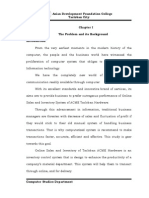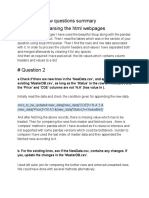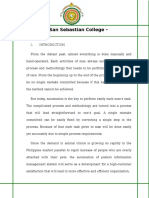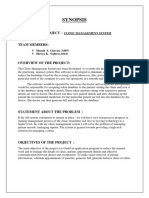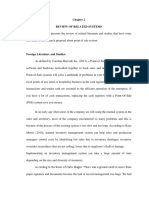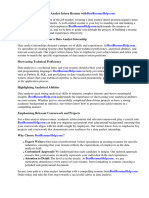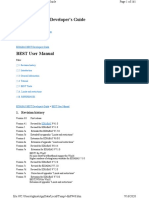Professional Documents
Culture Documents
RRL Sa Vet Revised
RRL Sa Vet Revised
Uploaded by
Sebastian Carlo Cabiades0 ratings0% found this document useful (0 votes)
1K views6 pagesVeterinary clinics provide medical care and treatment for animals. Transactions at veterinary clinics are currently manual and paper-based, making the process time-consuming. Developing an online veterinary management system could automate workflows and make the process more efficient. Existing systems have various modules that help with inventory management, medical records, billing, and generating reports. However, upgrading notification systems, such as using SMS, could further improve customer service and scheduling.
Original Description:
Original Title
RRL sa Vet Revised
Copyright
© © All Rights Reserved
Available Formats
DOCX, PDF, TXT or read online from Scribd
Share this document
Did you find this document useful?
Is this content inappropriate?
Report this DocumentVeterinary clinics provide medical care and treatment for animals. Transactions at veterinary clinics are currently manual and paper-based, making the process time-consuming. Developing an online veterinary management system could automate workflows and make the process more efficient. Existing systems have various modules that help with inventory management, medical records, billing, and generating reports. However, upgrading notification systems, such as using SMS, could further improve customer service and scheduling.
Copyright:
© All Rights Reserved
Available Formats
Download as DOCX, PDF, TXT or read online from Scribd
Download as docx, pdf, or txt
0 ratings0% found this document useful (0 votes)
1K views6 pagesRRL Sa Vet Revised
RRL Sa Vet Revised
Uploaded by
Sebastian Carlo CabiadesVeterinary clinics provide medical care and treatment for animals. Transactions at veterinary clinics are currently manual and paper-based, making the process time-consuming. Developing an online veterinary management system could automate workflows and make the process more efficient. Existing systems have various modules that help with inventory management, medical records, billing, and generating reports. However, upgrading notification systems, such as using SMS, could further improve customer service and scheduling.
Copyright:
© All Rights Reserved
Available Formats
Download as DOCX, PDF, TXT or read online from Scribd
Download as docx, pdf, or txt
You are on page 1of 6
Cabiades, Sebastian Carlo O. Prof. Gecilie C.
Almirañez
BSIT 3 – 1
A clinic is an establishment or hospital department where outpatients
are medically treated or advised, especially of a specialist nature. A
veterinary clinic is also a clinic but its patients are animals like dogs and
cats. Veterinary clinic means a facility for the medical care and treatment of
animals and involves provisions for their overnight accommodation but does
not include any outdoor facilities such as kennels, pen runs, and enclosures.
Just like humans, animals also need proper treatment because they can get
sick and hurt. Not only humans need a doctor but also our beloved pets.
Some pet owner likes to take care of more than one pet. Some have a cat,
dog, fish, birds, and even exotic animals. Just like us, animals are also
getting older, and sometimes as they get older they can be exposed to
different diseases and get some or ill. To treat our adored pets, we need to
take care of them and they also need their checkup to the vets. That being
said, we all know that most of the time, visiting a clinic can be a long wait.
Transactions in a veterinary clinic are manual, paper-based, and time-
consuming. Have you thought about making it an online system? How about
instead of paper-based, let’s make it paperless and automated?
Veterinary Management System (VMS) is a system that was developed
by Innovative Business Systems (IBS), Capron Corporation of Dallas. All IBS
software has been in operation and constantly improved since 1979. VMS
was planned by structured programming techniques, is totally integrated and
menu driven. VMS employs ample error trapping routines, operator
assistance, and professional data entry screens to guide the operator in
easily using the computer’s resources in managing the veterinarian’s
business without extensive knowledge of computers or complex computer
terminology (Veterinary Management System (VMS), 1988). VMS is
designed to completely run single or multi-veterinarian large animal, small
animal or mixed specialty practices. The program is a totally integrated
system design needing data entry only once. This system has a lot of
modules that will help the user to lessen his/her tasks. The first one is the
Total Inventory Management and this part of the program has a large
inventory tracking system with which all inventory is automatically deducted
when an invoice is created. This module provides the user with
comprehensive reports such as: sorting products by vendor, shelf location of
products, the last wholesale cost, retail price, date last used, dispensing
units, base measure per dispensing units, quantity remaining, and reorder
reports, to mention a few. Next is the Certificates. This module generates
professional vaccination certificates and health certificates as well as
heartworm certificates. Another module is the Total Accounts Receivable
Management. This one is the part of the program that makes your
receivables cost effective by providing clients with detailed billing and
invoicing, it will age accounts and automatically include interest and carrying
charges for overdue accounts. Also, it prints delinquency accounts, collection
accounts, and open item reports. Financial Management module provides
practitioners with many management reports such as, clinic cash
disbursements, detailed daily deposit slips, department summaries,
day/month-to-date/year comparison reports, procedure reports, practitioner
production report, and other clinic reports. Query Data Base Reports Writer
is an very powerful feature that allows the operator to create specific reports
for inquiry and printing from the database. Automatic Medical Treatment
History is a module that produces medical treatment history.
The Veterinary Practice Management System (VPMS) is a fully
integrated software system created for small to medium sized practices.
VPMS is aligned toward the practice with one to three veterinarians
(Doherty, 2019). VPMS features composed of different modules. First one is
the Point-of-Sale Invoicing with clinic copy of invoice. In this module,
invoicing procedures controls all business transactions. Next module is the
Inventory Control and Purchasing. This module consist of pricing updated
upon receipt of inventory, individual item control of retail markup, sales, tax,
etc, and user-defined inventory categories for revenue and practice analysis.
Professional Fee Schedule is sensitive to animal size. It allows for identified
inventory consumables to be automatically decremented at point-of-sale.
Just like in the first system, VPMS has also Accounts Receivable and
Accounts Payable. Next is the Linked Client/Patient Database. It
automatically searches the primary and alternate animal owners, search by
animal name and rabies tag number, facility for medical records/text entry
for each client and patient, and cross reference facility for manual client
records.
Management Information Systems or MIS is a term used to relate a
computer based solution which consists of a hardware and software
component. Automation plays a major role in any type of business. This will
convert a complicated process into an uncomplicated operation what will aid
in management decision making. Veterinary and Pet Shop Management
Information System is an online platform that will automate every
transactions containing the appointment scheduling, laboratory test, clients
and pet information, and many more (Ruby, 2011). The feature of the said
system has a lot of modules. First module is the Client/Pet Owner
Registration module. This stores the information of the pet owners such as
name, contact number, address, etc. Next one is the Pet Registration. It
stores the information of the pet/animal like animal name, type of animal,
breed, etc. Appointment Scheduling module sets an appointment and
schedule of consultation and check-up. Invoice Creation and Payment is the
module that will generate invoice for the customers and to produce the
payment as well. Product Management allows the user to encode the
products and accessories that is available in the store and can be examined
by the customers in the catalog section. Report Generation is the module
that will print out the records suchlike the list of the clients and pets, reports
on income, and many more.
Each medication typically requires specific instructions, including and
alerts for indications of possible side effects. Because there is such a notable
increase in the amount of medical information that a person must know to
optimally treat an animal’s condition, errors can occur that adversely affect
treatments and/or counteract or minimize the beneficial impact of the
medications. Problems arise when either the veterinarian making the
prescription or the person filing the prescription makes an error or provides
information that is not understood by one of the other parties. These errors
can be from transcription, misinterpretation, or insufficient information being
made accessible to the handler/owner. Giving incorrect doses to the animal,
giving doses to the animal at the wrong time, forgetting to give a dose,
stopping the medication too soon, or giving or administering the dosage
improperly that causes interactions are the most common owner originated
errors (Valley, 2002). A system following the present invention includes a
device for an animal handler or owner to use better control implementation
of medication therapies. The device will among other functions, the track
displays the medication name and purpose, the dosage, frequency, and
duration, possible side effects, the record of medications administered, and
the special instructions for regulating medications, such as with giving the
medication with or without meals, fluids, avoiding sunlight, etc.
The efficiency and accuracy through which an inventory system
operates are of utmost importance. Without an efficient system, it is unlikely
that participants will adhere to its use (Rooker, 2019). While many inventory
systems live from token/bin systems, third-part adapted systems, and even
veterinary software systems, no one system fits all practices. In
implementing an inventory system, there are things you should consider.
The first thing is that the system must be portable. It means that it can run
on a smartphone or tablet and can process in the field. Secondly, the system
must have real-time or delayed time synching. This means it will synch when
the practitioner has a data connection, which allows for more accurate
tracking as well as up-to-date inventory counts across the practice. Lastly, it
must be easy to use. This means that the categories must be easy to
navigate for staff as well as field operators and void of excessive menus or
actions.
The Short Message Service (SMS) lets text-based messages to be sent
to and from mobile telephones on a Global System for Mobile
Communications (GSM) networks. Each message has a limit of 160
characters. The possibility of using SMS in Africa is growing quickly high. It
is mainly used for things such as medicine awareness and warning
notifications. Many applications require the ability to do real-time notification
when events occur (Buxmann et al., 2020). Modern societies have begun
different market information systems such as Mobile application and Web-
based applications.
Of course, if we want to upgrade our system in terms of inventory and
other things, might as well upgrade our ways of notifying our patients’
owner when will be the follow-up checkup of their dear pets. One way to do
it is by using the SMS Notification System. Existing mass Short Message
Service (SMS) mailing systems are modeled to work with a specific SMS
gateway hence resulting in user lock-in to an SMS vendor. Also, some SMS
gateways support scheduling of SMS messages to be sent at a later time and
date, others do not support it. Moreover, those gateways that support
scheduling don't mostly allow users to cancel a scheduled SMS message
(Olaleye et al., 2013). The use of SMS as an effective means of personal
communication has widened the market of text messaging. This system has
a lot of purposes. It can be applied as a tool to provide SMS car parking
technique, as an administrative tool to support communication in higher
institutions of learning, and so much more. That being said, I think it can be
also used to merge with the system of our clinic. The system architecture is
composing of three tiers. These tiers are the Client Tier, Application Tier, and
the Back-End Tier. The Client Tier is the client-side. The user will be shown
formatted HTML pages resulting from JSP code, which will be presented to
the application middleware for processing. This will be the front-end of the
system and it is where the user will interact with the system. Application Tier
is the middleware side. The main application operated in this layer is JSP,
which will be processed by a web server. Furthermore, in this tier will be the
SSL protocol (Secure Sockets Layer) if it exists, to make sure the system
and data are secure from unauthorized users. The application tier is
composed of different components. The first component is a naming service
for storing instances of the various SMS gateways supported by the system.
Next is the thread pool of n size where n is the number of threads in the
pool. An executor service that will use the thread pool to perform tasks
submitted to it asynchronously. The system will also maintain a single
instance of a thread-safe collection object that will hold scheduled task
objects. To send a new SMS message, the system will obtain the appropriate
SMS gateway object from the naming service and call the gateway object to
send the method. To schedule a new SMS message, the system will acquire
the appropriate SMS gateway object from the naming service, create a task
object that will act as a closure for calling the SMS gateway object send
method, submit the task object to the scheduler instance in company with
the specified date and time of executing the task, store the scheduled task
object give back by the scheduler in the scheduled task list. The Back-End
Tier is the back-end side of the architecture and where all the data and
records are kept. It is also known as business data.
Buxmann, P., Hess, T., & Thatcher, J. B. (2020). AI-Based Information
Systems. Business & Information Systems Engineering.
https://doi.org/10.1007/s12599-020-00675-8
Doherty, C. (2019). Veterinary practice management. Canadian Veterinary
Journal, 60(7), 779–781. https://doi.org/10.1016/s0737-
0806(02)70157-3
Olaleye, O., Olaniyan, A., Eboda, O., & Awolere, A. (2013). SMS-Based
Event Notification System. 3(10), 55–62.
Rooker, E. J. (2019). Inventory management in the large animal veterinary
practice. 52(2), 227–229.
Ruby, R. (2011). Online Veterinary and Pet Shop Management Information
System. https://www.inettutor.com/source-code/online-veterinary-and-
pet-shop-management-information-system/
Valley, P. (2002). ( 12 ) United States Patent. 1(12).
Veterinary Management System (VMS). (1988). 29(March), 1988.
http://utpedia.utp.edu.my/10319/1/2011 Bachelor - Animal Health
System-Pet Health Clinic.pdf
You might also like
- I-Vet Veterinary Clinic Management SystemDocument40 pagesI-Vet Veterinary Clinic Management Systembeverly arevalo100% (1)
- Veterinary Management Information SystemDocument31 pagesVeterinary Management Information SystemRosenia Bali67% (3)
- CityVets Animal Clinic Management SystemDocument28 pagesCityVets Animal Clinic Management SystemTimothy Beldeniza67% (3)
- MIS Review of Related LiteratureDocument5 pagesMIS Review of Related LiteraturePatrick Jalos100% (1)
- Dental Clinic Management System (Capstone Project)Document81 pagesDental Clinic Management System (Capstone Project)Rona Jane Desoyo100% (2)
- Copilul Meu Nu Mananca - Carlos Gonzalez PDFDocument171 pagesCopilul Meu Nu Mananca - Carlos Gonzalez PDFLidia LuchianNo ratings yet
- Online Clinic Appointment System-Capstone ProjectDocument21 pagesOnline Clinic Appointment System-Capstone ProjectKaizne Escalante Abunagan100% (1)
- Sia RRLDocument16 pagesSia RRLPacetes Clarissa D.No ratings yet
- The Performance of Electronic Veterinary Management: Kongkarn Dullayachai Attawit ChangkamanonDocument4 pagesThe Performance of Electronic Veterinary Management: Kongkarn Dullayachai Attawit ChangkamanonSebastian Carlo CabiadesNo ratings yet
- Veterinary and Pet Shop Management Information System Thesis DocumentationDocument2 pagesVeterinary and Pet Shop Management Information System Thesis Documentationrutuja pawar43% (7)
- Chapter1 3Document31 pagesChapter1 3Fatima Licinia A. Peñalosa52% (29)
- Point of Sales System Chapter 2Document12 pagesPoint of Sales System Chapter 2Marla Angela M. Javier100% (1)
- Enrollment System Complete Capstone DocumentationDocument16 pagesEnrollment System Complete Capstone DocumentationRaymund Zuela100% (1)
- RRLDocument24 pagesRRLKarlaNo ratings yet
- Barangay Resident Record Management and Certificate Issuance System PDF Documentation Manual Method and Problems EncounteredDocument4 pagesBarangay Resident Record Management and Certificate Issuance System PDF Documentation Manual Method and Problems EncounteredLimon Michael50% (2)
- Micron Interview Questions Summary # Question 1 Parsing The HTML WebpagesDocument2 pagesMicron Interview Questions Summary # Question 1 Parsing The HTML WebpagesKartik SharmaNo ratings yet
- Chapter 1 and 2 (Updated)Document24 pagesChapter 1 and 2 (Updated)Sebastian Carlo Cabiades100% (1)
- Baste RRL Research VetDocument6 pagesBaste RRL Research VetSebastian Carlo CabiadesNo ratings yet
- CityVets Revised 1 & 2 (Edited)Document27 pagesCityVets Revised 1 & 2 (Edited)Sebastian Carlo Cabiades100% (1)
- Chapter 1,2 and 3Document28 pagesChapter 1,2 and 3Timothy BeldenizaNo ratings yet
- IntroductionDocument5 pagesIntroductionSaysain UkayNo ratings yet
- St. Jude Veterinary Management Information SystemDocument32 pagesSt. Jude Veterinary Management Information Systembeverly arevaloNo ratings yet
- grp8 Chap 1 To 3 S3a Pet Shop Management SystemDocument49 pagesgrp8 Chap 1 To 3 S3a Pet Shop Management SystemrafselaromNo ratings yet
- Chapter 2 RRLDocument7 pagesChapter 2 RRLAltaf T. HadjalaNo ratings yet
- 317 1.online Clinic Management SystemDocument4 pages317 1.online Clinic Management SystemJOHN REY CALANDRIANo ratings yet
- Review of Related LiteratureDocument8 pagesReview of Related LiteratureMark JuliusNo ratings yet
- Chapter 2 Dental ClinicDocument5 pagesChapter 2 Dental ClinicJunard Dominguez100% (1)
- Chapter 1 2 PosDocument7 pagesChapter 1 2 PosSophia Nichole Contreras100% (2)
- Chap 1-3 - Patients Monitoring Record System For Ignacio Dental ClinicDocument29 pagesChap 1-3 - Patients Monitoring Record System For Ignacio Dental ClinicDeedeeNo ratings yet
- Chapter 1 Dental ClinicDocument6 pagesChapter 1 Dental ClinicJunard DominguezNo ratings yet
- Chapter 3 SadDocument11 pagesChapter 3 SadMikho ValenciaNo ratings yet
- Chapter II - Review of Related Literature and StudiesDocument6 pagesChapter II - Review of Related Literature and Studiespaul Adrian reyes100% (6)
- Barangay NewDocument39 pagesBarangay NewRonald RiveraNo ratings yet
- Review of Related Literature and StudiesDocument11 pagesReview of Related Literature and Studiesanne tuquinNo ratings yet
- Dental Clinic Record Management and Appointment System For JR Viray Dental and Aesthetic Medicine 1Document64 pagesDental Clinic Record Management and Appointment System For JR Viray Dental and Aesthetic Medicine 1Unnie NicaNo ratings yet
- Chapter IIDocument6 pagesChapter IIbhieetotx60% (5)
- Chapter 1 Thesis Sad SampleDocument11 pagesChapter 1 Thesis Sad SampleMikho Valencia75% (4)
- Ok - Thesis Final - BSCS FormatDocument32 pagesOk - Thesis Final - BSCS FormatRenz Floyd FamaranNo ratings yet
- Title Proposal - Online Veterinary Management Information SystemDocument3 pagesTitle Proposal - Online Veterinary Management Information Systemwilliam sumalpongNo ratings yet
- Review of Related LiteratureDocument9 pagesReview of Related LiteratureAlina Aire MacatangayNo ratings yet
- Web Based Inventory FebDocument45 pagesWeb Based Inventory FebSamiracomputerstation Kuya MarvsNo ratings yet
- Patient Information SystemDocument14 pagesPatient Information SystemJomiener Bawar Ramos27% (11)
- Clinic SystemDocument5 pagesClinic Systemmanali chavan100% (1)
- Chapter 1 2 and 3Document10 pagesChapter 1 2 and 3Saysain UkayNo ratings yet
- Veterinary Clinic Management System: Graduation ProjectDocument35 pagesVeterinary Clinic Management System: Graduation ProjectRebecca BenitezNo ratings yet
- Sales and Inventory Monitoring SystemDocument7 pagesSales and Inventory Monitoring SystemAriel John PagulayanNo ratings yet
- Related Review of Literature and SystemDocument8 pagesRelated Review of Literature and Systemgenerey de pazNo ratings yet
- CHAPTER II - RRL For InventoryDocument4 pagesCHAPTER II - RRL For InventoryDiana Rose BautistaNo ratings yet
- Web Based and Online Application For Capstone and Thesis ProjectDocument2 pagesWeb Based and Online Application For Capstone and Thesis ProjectEmil Tamayo0% (2)
- Patient Record Management System Proposal CorrectedDocument18 pagesPatient Record Management System Proposal CorrectedJo Fel Garcia78% (9)
- Capstone Project Title:: A Water Billing Sytem With Due Date Sms Notification in Dolores, QuezonDocument2 pagesCapstone Project Title:: A Water Billing Sytem With Due Date Sms Notification in Dolores, QuezonRochelle Marie Regencia100% (1)
- Foreign Studies About Inventory SystemDocument2 pagesForeign Studies About Inventory SystemAnonymous 1ze6UmWM571% (49)
- A Point of Sale Inventory Management System Allows A Business Owner To Havemore Than One Business Location and Adequately Keep Track of Inventory at Each Withoutbeing PresentDocument3 pagesA Point of Sale Inventory Management System Allows A Business Owner To Havemore Than One Business Location and Adequately Keep Track of Inventory at Each Withoutbeing PresentReign LozanoNo ratings yet
- Chapter1 1 1Document31 pagesChapter1 1 1Bummy Mangonon PepitoNo ratings yet
- Bantay Baha 2020Document28 pagesBantay Baha 2020Junard Dominguez100% (2)
- A Design of A Vet Clinic Management System For Tri Star ClinicDocument57 pagesA Design of A Vet Clinic Management System For Tri Star ClinicLaurence Nina Ortiz100% (1)
- Book Borrowing System in Northern Mindanao Colleges LibraryDocument32 pagesBook Borrowing System in Northern Mindanao Colleges LibraryHanz Dela Cruz100% (4)
- Chapter 2Document4 pagesChapter 2Roselie Cuenca94% (16)
- Thesis 123Document16 pagesThesis 123dlanorleurab75% (4)
- Point of Sale and Inventory System Capstone ProjectDocument4 pagesPoint of Sale and Inventory System Capstone ProjectAhmed AbdiNo ratings yet
- Hospital Information System: Current Scenario (Discuss How Computers and IT Are Valuable To The Organization)Document12 pagesHospital Information System: Current Scenario (Discuss How Computers and IT Are Valuable To The Organization)ChenYu WangNo ratings yet
- Island Pets Veterinary Clinic With SMS NotificationDocument3 pagesIsland Pets Veterinary Clinic With SMS NotificationRixel Penoria BalacuitNo ratings yet
- IT & Ecommerce - Aug23Document4 pagesIT & Ecommerce - Aug23Suba SomayahNo ratings yet
- Finding The Right Reference Materials: Renato O. Arazo, PH.DDocument53 pagesFinding The Right Reference Materials: Renato O. Arazo, PH.DSebastian Carlo CabiadesNo ratings yet
- An Integrated Information Management System For Barangay 1-A Davao: Profiling, Incident Recording, Project/Program Monitoring and Document RequestDocument49 pagesAn Integrated Information Management System For Barangay 1-A Davao: Profiling, Incident Recording, Project/Program Monitoring and Document RequestSebastian Carlo CabiadesNo ratings yet
- This Study Resource Was: Literature Review Review of Related Literature, Studies or SystemsDocument5 pagesThis Study Resource Was: Literature Review Review of Related Literature, Studies or SystemsSebastian Carlo CabiadesNo ratings yet
- Protection Profile For E Certificate IssDocument27 pagesProtection Profile For E Certificate IssSebastian Carlo CabiadesNo ratings yet
- Computerised Management System of The Veterinary Service in The Slovak Socialist RepublicDocument26 pagesComputerised Management System of The Veterinary Service in The Slovak Socialist RepublicSebastian Carlo CabiadesNo ratings yet
- United States Patent: (10) Patent No.: (45) Date of PatentDocument16 pagesUnited States Patent: (10) Patent No.: (45) Date of PatentSebastian Carlo CabiadesNo ratings yet
- Pet Shop Management System For Klinik Veterinar & Surgeri JawhariDocument4 pagesPet Shop Management System For Klinik Veterinar & Surgeri JawhariSebastian Carlo CabiadesNo ratings yet
- Parkview Pet Hospital - Veterinary Practice Management System DeveDocument24 pagesParkview Pet Hospital - Veterinary Practice Management System DeveSebastian Carlo CabiadesNo ratings yet
- United States Patent (19) : (45) Date of Patent: Dec. 1, 1998Document12 pagesUnited States Patent (19) : (45) Date of Patent: Dec. 1, 1998Sebastian Carlo CabiadesNo ratings yet
- Barangay Information System: Brgy. Ilang, San Carlos City, PangasinanDocument18 pagesBarangay Information System: Brgy. Ilang, San Carlos City, PangasinanSebastian Carlo CabiadesNo ratings yet
- Chapter 2 TheConceptofEnterpriseArchitectureDocument42 pagesChapter 2 TheConceptofEnterpriseArchitectureSebastian Carlo CabiadesNo ratings yet
- Barangay Information System: Brgy. Ilang, San Carlos City, PangasinanDocument18 pagesBarangay Information System: Brgy. Ilang, San Carlos City, PangasinanSebastian Carlo Cabiades100% (1)
- FT Aspx PDFDocument11 pagesFT Aspx PDFSebastian Carlo CabiadesNo ratings yet
- United States Patent: (10) Patent No.: US 6,397,190 B1Document37 pagesUnited States Patent: (10) Patent No.: US 6,397,190 B1Sebastian Carlo CabiadesNo ratings yet
- J54 S4hana1909 BPD en UsDocument43 pagesJ54 S4hana1909 BPD en UsBiji RoyNo ratings yet
- DRIVES-FT-CC-004 - Altivar Process ATV6x0 Update - 250116 - Rev 2Document32 pagesDRIVES-FT-CC-004 - Altivar Process ATV6x0 Update - 250116 - Rev 2Edwin RamírezNo ratings yet
- Manufacturing Resume SamplesDocument7 pagesManufacturing Resume Samplesafjzcgeoylbkku100% (2)
- Computer Science Practical NotesDocument35 pagesComputer Science Practical NotesSelvakumardxbNo ratings yet
- Um en Charx Sec 109999 en 02Document172 pagesUm en Charx Sec 109999 en 02Enemy5No ratings yet
- External SortingDocument5 pagesExternal SortingXYZ ABCDNo ratings yet
- Data Analyst Intern ResumeDocument4 pagesData Analyst Intern Resumepoxhmpckg100% (1)
- Chapter 2 - Development Process and OrganizationsDocument23 pagesChapter 2 - Development Process and Organizationshisham_eyesNo ratings yet
- Introduction To Real-Time SystemsDocument32 pagesIntroduction To Real-Time SystemsSachin KNo ratings yet
- Career Objective:: Master of Computer Application, Bachelor of Computer Science, Higher Secondary Course, 2006Document4 pagesCareer Objective:: Master of Computer Application, Bachelor of Computer Science, Higher Secondary Course, 2006andrw1987No ratings yet
- Remotesensing 13 03363 With CoverDocument25 pagesRemotesensing 13 03363 With Coverviludhugal1996No ratings yet
- Ankush Agarwal: Work Experience SkillsDocument1 pageAnkush Agarwal: Work Experience SkillsAkash TrivediNo ratings yet
- h18336 Powerstore Sap Hana VGDocument55 pagesh18336 Powerstore Sap Hana VGAnilNo ratings yet
- Internet of Things Based Pet Feeder Automation Using Raspberry PiDocument7 pagesInternet of Things Based Pet Feeder Automation Using Raspberry PiRizyn ShresthaNo ratings yet
- Definition of Stack: A Stack Is A in Which Insertions and Deletions Are Allowed Only Called TheDocument38 pagesDefinition of Stack: A Stack Is A in Which Insertions and Deletions Are Allowed Only Called Thenagarjuna0595No ratings yet
- Isce Computer Previous Yr Question Ppr. (2019-2014)Document123 pagesIsce Computer Previous Yr Question Ppr. (2019-2014)ACCELALORDNo ratings yet
- Ediabas Best GuideDocument161 pagesEdiabas Best Guideedward carrollNo ratings yet
- Proposal For A Document Management System in The Modern UniversityDocument12 pagesProposal For A Document Management System in The Modern UniversityBHG GlobaltechNo ratings yet
- LSC Smart Connect FaqDocument59 pagesLSC Smart Connect FaqboekenkastNo ratings yet
- 2nd Puc Computer Science Notes PDF (1 Mark Questions and Answers) - 2nd Puc Computer ScienceDocument11 pages2nd Puc Computer Science Notes PDF (1 Mark Questions and Answers) - 2nd Puc Computer ScienceMohan Kumar67% (3)
- Terminal EDocument19 pagesTerminal Emdinyati81No ratings yet
- Commercial Internet Banking: Trade Service ModuleDocument33 pagesCommercial Internet Banking: Trade Service ModuleManvi PareekNo ratings yet
- PONSSE - Product Line - ENGDocument25 pagesPONSSE - Product Line - ENGtystar_21No ratings yet
- Mastering Ruby On Rails - A Beginner's Guide-CRC Press (2022)Document341 pagesMastering Ruby On Rails - A Beginner's Guide-CRC Press (2022)Danilo CândidoNo ratings yet
- Pega Csa TestDocument44 pagesPega Csa TestMohanavel KathirvelNo ratings yet
- Errors in Java - 9th - ICSEDocument7 pagesErrors in Java - 9th - ICSEnishanthchandran782No ratings yet
- Exceed / Xcite: Ram Clear ProcedureDocument3 pagesExceed / Xcite: Ram Clear Procedurepablo bulzomiNo ratings yet
- WidgetsDocument17 pagesWidgetsGitesh MoreNo ratings yet










